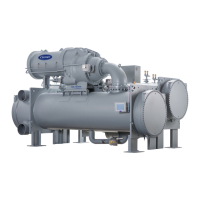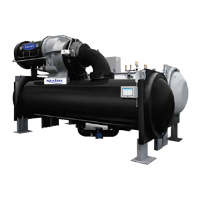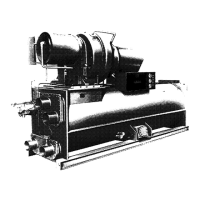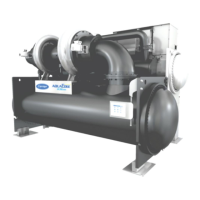55
on the SETUP1 table. The compressor will restart when the
chiller is:
• in LCW CONTROL and the LEAVING CHILLED
WATER temperature is greater than the CONTROL
POINT plus the (RECYCLE CONTROL) RESTART
DELTA T.
•in ECW CONTROL and the ENTERING CHILLED
WATER temperature is greater than the CONTROL
POINT plus the (RECYCLE CONTROL) RESTART
DELTA T.
Once these conditions are met, the compressor initiates a
start-up with a normal start-up sequence.
An alert condition may be generated if 5 or more recycle
start-ups occur in less than 4 hours. Excessive recycling can
reduce chiller life; therefore, compressor recycling due to
extremely low loads should be reduced.
To reduce compressor recycling, use the time schedule to
shut the chiller down during known low load operation period,
or increase the chiller load by running the fan systems. If the
hot gas bypass is installed, adjust the values to ensure that hot
gas is energized during light load conditions. Increase the
(RECYCLE CONTROL) RESTART DELTA T on the SETUP1
table to lengthen the time between restarts.
The chiller should not be operated below design minimum
load without a hot gas bypass installed.
Safety Shutdown — A safety shutdown is identical to
a manual shutdown with the exception that, during a safety
shutdown, the ICVC displays the reason for the shutdown, the
alarm light blinks continuously, and the spare alarm contacts
are energized.
After a safety shutdown, the softkey must be pressed
to clear the alarm. If the alarm condition is still present, the alarm
light continues to blink. Once the alarm is cleared, the operator
must press the or softkeys to restart the chiller.
BEFORE INITIAL START-UP
Job Data Required
• list of applicable design temperatures and pressures
(product data submittal)
• chiller certified prints
• starting equipment details and wiring diagrams
• diagrams and instructions for special controls or options
• pumpout unit instructions
Equipment Required
• mechanic’s tools (refrigeration) including T30 torx
• True RMS digital multimeter with clamp-on current
probe or True RMS digital clamp-on meter rated for at
least 480 vac or 700 vdc
• electronic leak detector
• absolute pressure manometer or wet-bulb vacuum
indicator (Fig. 28)
• 500-v insulation tester (megohmmeter) for compressor
motors with nameplate voltage of 600 v or less, or a
5000-v insulation tester for compressor motor rated
above 600 v
Using the Optional Storage Tank and Pump-
out System —
Refer to Chillers with Storage Tanks sec-
tion, page 74 for pumpout system preparation, refrigerant
transfer, and chiller evacuation.
Remove Shipping Packaging — Remove any pack-
aging material from the control panel, power panel, guide vane
actuator, motor cooling and oil reclaim solenoids, motor and
bearing temperature sensor covers, and the VFD.
Open Oil Circuit Valves — Check to ensure the oil fil-
ter isolation valves (Fig. 4) are open by removing the valve cap
and checking the valve stem.
Oil Charge — The oil charge for the 19XRV compressor
depends on the compressor Frame size:
• Frame 2 compressor — 8 gal (30 L)
• Frame 3 compressor — 8 gal (30 L)
• Frame 4 compressor — 10 gal (37.8 L)
• Frame 4 compressor with split ring diffuser option —
12 gal (45 L)
• Frame 5 compressor — 18 gal (67.8 L)
The chiller is shipped with oil in the compressor. When the
sump is full, the oil level should be no higher than the middle
of the upper sight glass, and minimum level is the bottom
of the lower sight glass (Fig. 2). If oil is added, it must meet
Carrier’s specification for centrifugal compressor use as
described in the Oil Specification section. Charge the oil
through the oil charging valve located near the bottom of the
transmission housing (Fig. 2). The oil must be pumped from
the oil container through the charging valve due to higher
refrigerant pressure. The pumping device must be able to lift
from 0 to 200 psig (0 to 1380 kPa) or above unit pressure. Oil
should only be charged or removed when the chiller is shut
down.
Tighten All Gasketed Joints and Guide Vane
Shaft Packing —
Gaskets and packing normally relax by
the time the chiller arrives at the jobsite. Tighten all gasketed
joints and the guide vane shaft packing to ensure a leak-tight
chiller. Gasketed joints (excluding O-rings) may include joints
at some or all of the following:
• Waterbox covers
• Compressor suction elbow flanges (at compressor and at
the cooler)
• Compressor discharge flange
• Compressor discharge line spacer (both sides) if no isola-
tion valve
• Cooler inlet line spacer (both sides) if no isolation valve
• Hot gas bypass valve (both sides of valve)
• Hot gas bypass flange at compressor
Refer to Table 10 for bolt torque requirements.
RESET
CCN LOCAL
Fig. 28 — Typical Wet-Bulb Type
Vacuum Indicator
a19-658

